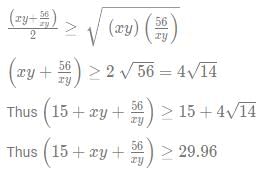CAT Exam > CAT Questions > 2 positive numbersxandyare such thatp. If N i...
Start Learning for Free
2 positive numbers x and y are such that  p. If N is the maximum possible integral value of pp such that this inequality holds for all the values of xx and yy. How many factors does N2 has?
p. If N is the maximum possible integral value of pp such that this inequality holds for all the values of xx and yy. How many factors does N2 has?
 p. If N is the maximum possible integral value of pp such that this inequality holds for all the values of xx and yy. How many factors does N2 has?
p. If N is the maximum possible integral value of pp such that this inequality holds for all the values of xx and yy. How many factors does N2 has?Correct answer is '3'. Can you explain this answer?
| FREE This question is part of | Download PDF Attempt this Test |
Verified Answer
2 positive numbersxandyare such thatp. If N is themaximum possible int...
Let us multiply the 2 terms,
We get

Upon simplifying we get

Upon applying AM-GM inequality on xy+ 56/xy

Maximum possible integral value of p = 29 = N
N2 = 292. Thus N2 will have 2+1 = 3 factors

|
Explore Courses for CAT exam
|

|
Similar CAT Doubts
2 positive numbersxandyare such thatp. If N is themaximum possible integralvalue ofppsuch that this inequality holds for all the values ofxxandyy. How many factors doesN2has?Correct answer is '3'. Can you explain this answer?
Question Description
2 positive numbersxandyare such thatp. If N is themaximum possible integralvalue ofppsuch that this inequality holds for all the values ofxxandyy. How many factors doesN2has?Correct answer is '3'. Can you explain this answer? for CAT 2024 is part of CAT preparation. The Question and answers have been prepared according to the CAT exam syllabus. Information about 2 positive numbersxandyare such thatp. If N is themaximum possible integralvalue ofppsuch that this inequality holds for all the values ofxxandyy. How many factors doesN2has?Correct answer is '3'. Can you explain this answer? covers all topics & solutions for CAT 2024 Exam. Find important definitions, questions, meanings, examples, exercises and tests below for 2 positive numbersxandyare such thatp. If N is themaximum possible integralvalue ofppsuch that this inequality holds for all the values ofxxandyy. How many factors doesN2has?Correct answer is '3'. Can you explain this answer?.
2 positive numbersxandyare such thatp. If N is themaximum possible integralvalue ofppsuch that this inequality holds for all the values ofxxandyy. How many factors doesN2has?Correct answer is '3'. Can you explain this answer? for CAT 2024 is part of CAT preparation. The Question and answers have been prepared according to the CAT exam syllabus. Information about 2 positive numbersxandyare such thatp. If N is themaximum possible integralvalue ofppsuch that this inequality holds for all the values ofxxandyy. How many factors doesN2has?Correct answer is '3'. Can you explain this answer? covers all topics & solutions for CAT 2024 Exam. Find important definitions, questions, meanings, examples, exercises and tests below for 2 positive numbersxandyare such thatp. If N is themaximum possible integralvalue ofppsuch that this inequality holds for all the values ofxxandyy. How many factors doesN2has?Correct answer is '3'. Can you explain this answer?.
Solutions for 2 positive numbersxandyare such thatp. If N is themaximum possible integralvalue ofppsuch that this inequality holds for all the values ofxxandyy. How many factors doesN2has?Correct answer is '3'. Can you explain this answer? in English & in Hindi are available as part of our courses for CAT.
Download more important topics, notes, lectures and mock test series for CAT Exam by signing up for free.
Here you can find the meaning of 2 positive numbersxandyare such thatp. If N is themaximum possible integralvalue ofppsuch that this inequality holds for all the values ofxxandyy. How many factors doesN2has?Correct answer is '3'. Can you explain this answer? defined & explained in the simplest way possible. Besides giving the explanation of
2 positive numbersxandyare such thatp. If N is themaximum possible integralvalue ofppsuch that this inequality holds for all the values ofxxandyy. How many factors doesN2has?Correct answer is '3'. Can you explain this answer?, a detailed solution for 2 positive numbersxandyare such thatp. If N is themaximum possible integralvalue ofppsuch that this inequality holds for all the values ofxxandyy. How many factors doesN2has?Correct answer is '3'. Can you explain this answer? has been provided alongside types of 2 positive numbersxandyare such thatp. If N is themaximum possible integralvalue ofppsuch that this inequality holds for all the values ofxxandyy. How many factors doesN2has?Correct answer is '3'. Can you explain this answer? theory, EduRev gives you an
ample number of questions to practice 2 positive numbersxandyare such thatp. If N is themaximum possible integralvalue ofppsuch that this inequality holds for all the values ofxxandyy. How many factors doesN2has?Correct answer is '3'. Can you explain this answer? tests, examples and also practice CAT tests.

|
Explore Courses for CAT exam
|

|
Suggested Free Tests
Signup for Free!
Signup to see your scores go up within 7 days! Learn & Practice with 1000+ FREE Notes, Videos & Tests.























